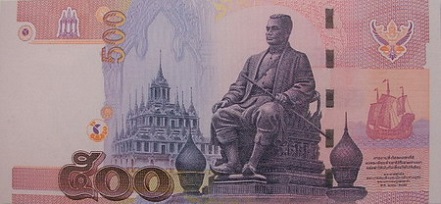A colorful five dollar Australian note. In 1965, Australia adopted the name "royal" for its currency, but it was later dropped in favor of the dollar.
A note for one Egyptian pound.
A 20 rand note from South Africa. Each in this series of banknotes features a different animal from the "big five".
A 500 baht note from Thailand.
A Surinamese ten dollar note. The dollar replaced the Surinamese guilder in January 2004.
A one lempira note from Honduras. The note is named after Lempira (d. 1537) who was a war captain of the Lencas of western Honduras in Central America during the 1530s, when he led resistance to Francisco de Montejo's attempts to conquer and incorporate the region into the province of Honduras.
A 1000 rupees note from India. The text on the left hand side of the note has 1000 rupees written in the 18 major languages that are spoken in India, including English and Hindi.
The front and back side of Costa Rican banknote for five colones. It shows Rafael Yglesia Castro, president of Costa Rica from 1894 to 1902 and a Guaria Morada orchid, Costa Rica's national flower.
South American countries do have a penchant for colorful and exotic things, including their bank notes. My personal favorites are Costa Rica, Honduras and Suriname and I hope to visit these places one day. What say?








No comments:
Post a Comment